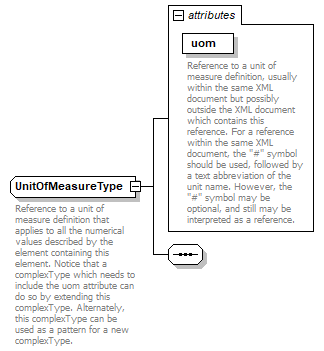| diagram |  |
||||||||||||||
| namespace | http://www.opengis.net/gml | ||||||||||||||
| used by |
|
||||||||||||||
| attributes |
|
||||||||||||||
| annotation |
|
||||||||||||||
| source | <xs:complexType name="UnitOfMeasureType"> <xs:annotation> <xs:documentation>Reference to a unit of measure definition that applies to all the numerical values described by the element containing this element. Notice that a complexType which needs to include the uom attribute can do so by extending this complexType. Alternately, this complexType can be used as a pattern for a new complexType.</xs:documentation> </xs:annotation> <xs:sequence/> <xs:attribute name="uom" type="anyURI" use="required"> <xs:annotation> <xs:documentation>Reference to a unit of measure definition, usually within the same XML document but possibly outside the XML document which contains this reference. For a reference within the same XML document, the "#" symbol should be used, followed by a text abbreviation of the unit name. However, the "#" symbol may be optional, and still may be interpreted as a reference.</xs:documentation> </xs:annotation> </xs:attribute> </xs:complexType> |
attribute UnitOfMeasureType/@uom
| type | xs:anyURI | ||||
| properties |
|
||||
| annotation |
|
||||
| source | <xs:attribute name="uom" type="anyURI" use="required"> <xs:annotation> <xs:documentation>Reference to a unit of measure definition, usually within the same XML document but possibly outside the XML document which contains this reference. For a reference within the same XML document, the "#" symbol should be used, followed by a text abbreviation of the unit name. However, the "#" symbol may be optional, and still may be interpreted as a reference.</xs:documentation> </xs:annotation> </xs:attribute> |
XML Schema documentation generated by XMLSpy Schema Editor http://www.altova.com/xmlspy